University IoT Security and Privacy Issues in Smart Cities Research
VerifiedAdded on 2022/11/28
|23
|6142
|87
Report
AI Summary
This research paper explores the security and privacy challenges associated with the implementation of the Internet of Things (IoT) in smart cities. It examines the significance of IoT in enhancing city services and improving the lives of residents through data collection and analysis. The paper identifies various security vulnerabilities, including those related to constrained devices, weak encryption, communication technologies, and cloud layers. It also discusses the impact of human factors and legacy systems on security. The research aims to understand major security risks, mitigation techniques, and the components contributing to security issues, while also highlighting the advantages of IoT technology in smart cities. The paper outlines the research plan, including the research philosophy, approach, design, data collection procedures, sampling methods, data analysis methods, and expected outcomes. A Gantt chart provides a schedule for the research activities, and the paper concludes with a summary of the findings and references.
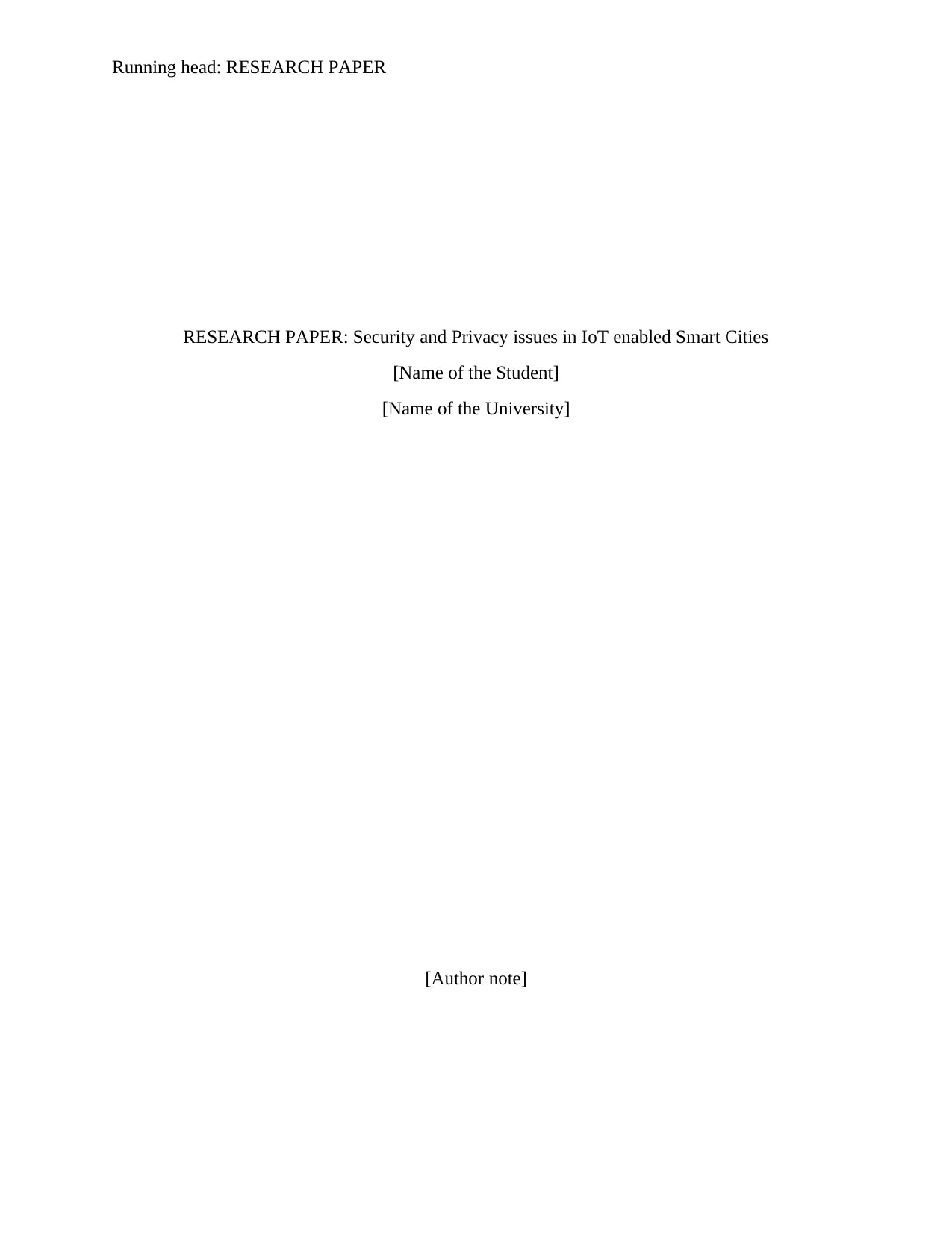
Running head: RESEARCH PAPER
RESEARCH PAPER: Security and Privacy issues in IoT enabled Smart Cities
[Name of the Student]
[Name of the University]
[Author note]
RESEARCH PAPER: Security and Privacy issues in IoT enabled Smart Cities
[Name of the Student]
[Name of the University]
[Author note]
Paraphrase This Document
Need a fresh take? Get an instant paraphrase of this document with our AI Paraphraser
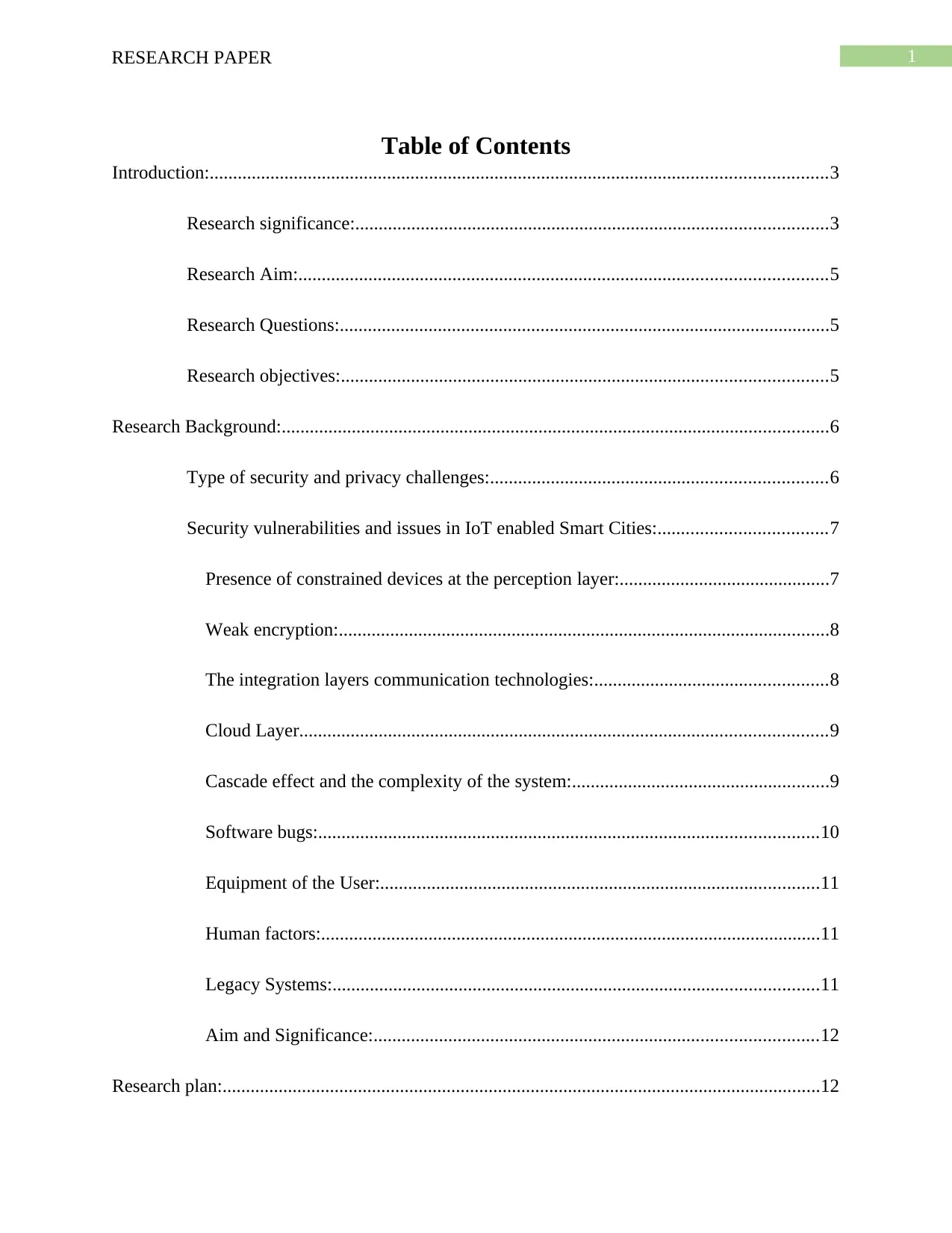
1RESEARCH PAPER
Table of Contents
Introduction:....................................................................................................................................3
Research significance:.....................................................................................................3
Research Aim:.................................................................................................................5
Research Questions:.........................................................................................................5
Research objectives:........................................................................................................5
Research Background:.....................................................................................................................6
Type of security and privacy challenges:........................................................................6
Security vulnerabilities and issues in IoT enabled Smart Cities:....................................7
Presence of constrained devices at the perception layer:.............................................7
Weak encryption:.........................................................................................................8
The integration layers communication technologies:..................................................8
Cloud Layer.................................................................................................................9
Cascade effect and the complexity of the system:.......................................................9
Software bugs:...........................................................................................................10
Equipment of the User:..............................................................................................11
Human factors:...........................................................................................................11
Legacy Systems:........................................................................................................11
Aim and Significance:...............................................................................................12
Research plan:................................................................................................................................12
Table of Contents
Introduction:....................................................................................................................................3
Research significance:.....................................................................................................3
Research Aim:.................................................................................................................5
Research Questions:.........................................................................................................5
Research objectives:........................................................................................................5
Research Background:.....................................................................................................................6
Type of security and privacy challenges:........................................................................6
Security vulnerabilities and issues in IoT enabled Smart Cities:....................................7
Presence of constrained devices at the perception layer:.............................................7
Weak encryption:.........................................................................................................8
The integration layers communication technologies:..................................................8
Cloud Layer.................................................................................................................9
Cascade effect and the complexity of the system:.......................................................9
Software bugs:...........................................................................................................10
Equipment of the User:..............................................................................................11
Human factors:...........................................................................................................11
Legacy Systems:........................................................................................................11
Aim and Significance:...............................................................................................12
Research plan:................................................................................................................................12
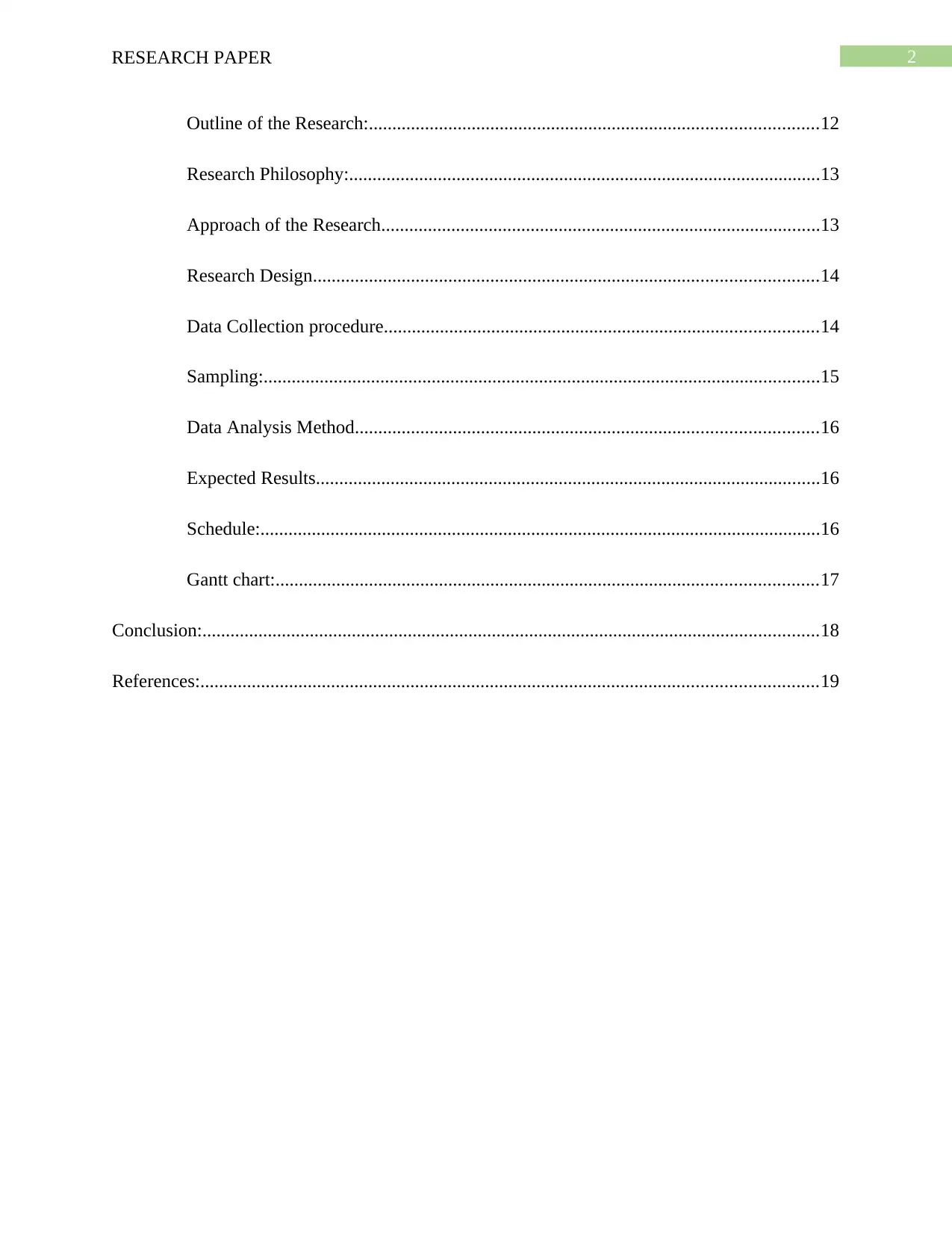
2RESEARCH PAPER
Outline of the Research:................................................................................................12
Research Philosophy:.....................................................................................................13
Approach of the Research..............................................................................................13
Research Design............................................................................................................14
Data Collection procedure.............................................................................................14
Sampling:.......................................................................................................................15
Data Analysis Method...................................................................................................16
Expected Results............................................................................................................16
Schedule:........................................................................................................................16
Gantt chart:....................................................................................................................17
Conclusion:....................................................................................................................................18
References:....................................................................................................................................19
Outline of the Research:................................................................................................12
Research Philosophy:.....................................................................................................13
Approach of the Research..............................................................................................13
Research Design............................................................................................................14
Data Collection procedure.............................................................................................14
Sampling:.......................................................................................................................15
Data Analysis Method...................................................................................................16
Expected Results............................................................................................................16
Schedule:........................................................................................................................16
Gantt chart:....................................................................................................................17
Conclusion:....................................................................................................................................18
References:....................................................................................................................................19
⊘ This is a preview!⊘
Do you want full access?
Subscribe today to unlock all pages.

Trusted by 1+ million students worldwide
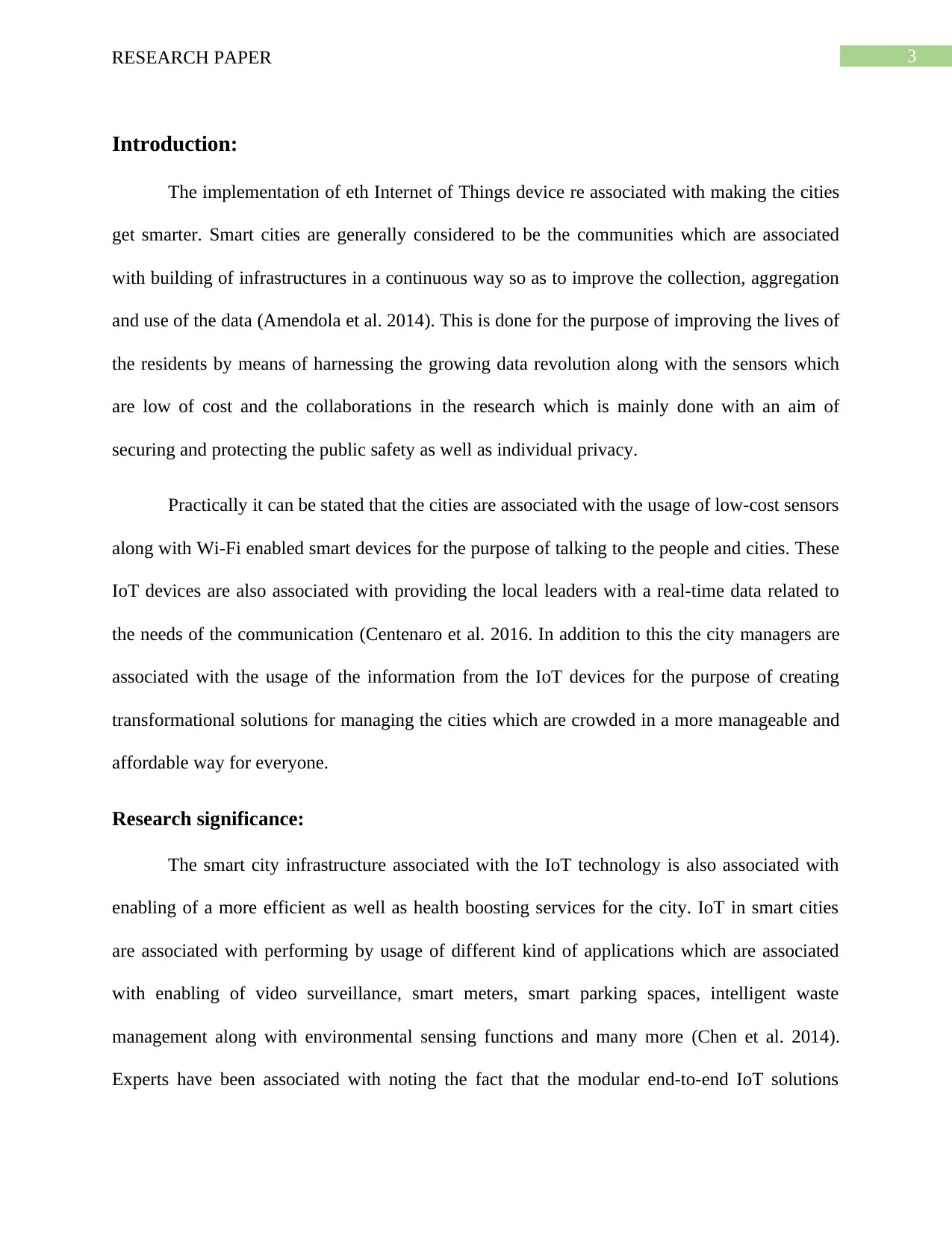
3RESEARCH PAPER
Introduction:
The implementation of eth Internet of Things device re associated with making the cities
get smarter. Smart cities are generally considered to be the communities which are associated
with building of infrastructures in a continuous way so as to improve the collection, aggregation
and use of the data (Amendola et al. 2014). This is done for the purpose of improving the lives of
the residents by means of harnessing the growing data revolution along with the sensors which
are low of cost and the collaborations in the research which is mainly done with an aim of
securing and protecting the public safety as well as individual privacy.
Practically it can be stated that the cities are associated with the usage of low-cost sensors
along with Wi-Fi enabled smart devices for the purpose of talking to the people and cities. These
IoT devices are also associated with providing the local leaders with a real-time data related to
the needs of the communication (Centenaro et al. 2016. In addition to this the city managers are
associated with the usage of the information from the IoT devices for the purpose of creating
transformational solutions for managing the cities which are crowded in a more manageable and
affordable way for everyone.
Research significance:
The smart city infrastructure associated with the IoT technology is also associated with
enabling of a more efficient as well as health boosting services for the city. IoT in smart cities
are associated with performing by usage of different kind of applications which are associated
with enabling of video surveillance, smart meters, smart parking spaces, intelligent waste
management along with environmental sensing functions and many more (Chen et al. 2014).
Experts have been associated with noting the fact that the modular end-to-end IoT solutions
Introduction:
The implementation of eth Internet of Things device re associated with making the cities
get smarter. Smart cities are generally considered to be the communities which are associated
with building of infrastructures in a continuous way so as to improve the collection, aggregation
and use of the data (Amendola et al. 2014). This is done for the purpose of improving the lives of
the residents by means of harnessing the growing data revolution along with the sensors which
are low of cost and the collaborations in the research which is mainly done with an aim of
securing and protecting the public safety as well as individual privacy.
Practically it can be stated that the cities are associated with the usage of low-cost sensors
along with Wi-Fi enabled smart devices for the purpose of talking to the people and cities. These
IoT devices are also associated with providing the local leaders with a real-time data related to
the needs of the communication (Centenaro et al. 2016. In addition to this the city managers are
associated with the usage of the information from the IoT devices for the purpose of creating
transformational solutions for managing the cities which are crowded in a more manageable and
affordable way for everyone.
Research significance:
The smart city infrastructure associated with the IoT technology is also associated with
enabling of a more efficient as well as health boosting services for the city. IoT in smart cities
are associated with performing by usage of different kind of applications which are associated
with enabling of video surveillance, smart meters, smart parking spaces, intelligent waste
management along with environmental sensing functions and many more (Chen et al. 2014).
Experts have been associated with noting the fact that the modular end-to-end IoT solutions
Paraphrase This Document
Need a fresh take? Get an instant paraphrase of this document with our AI Paraphraser
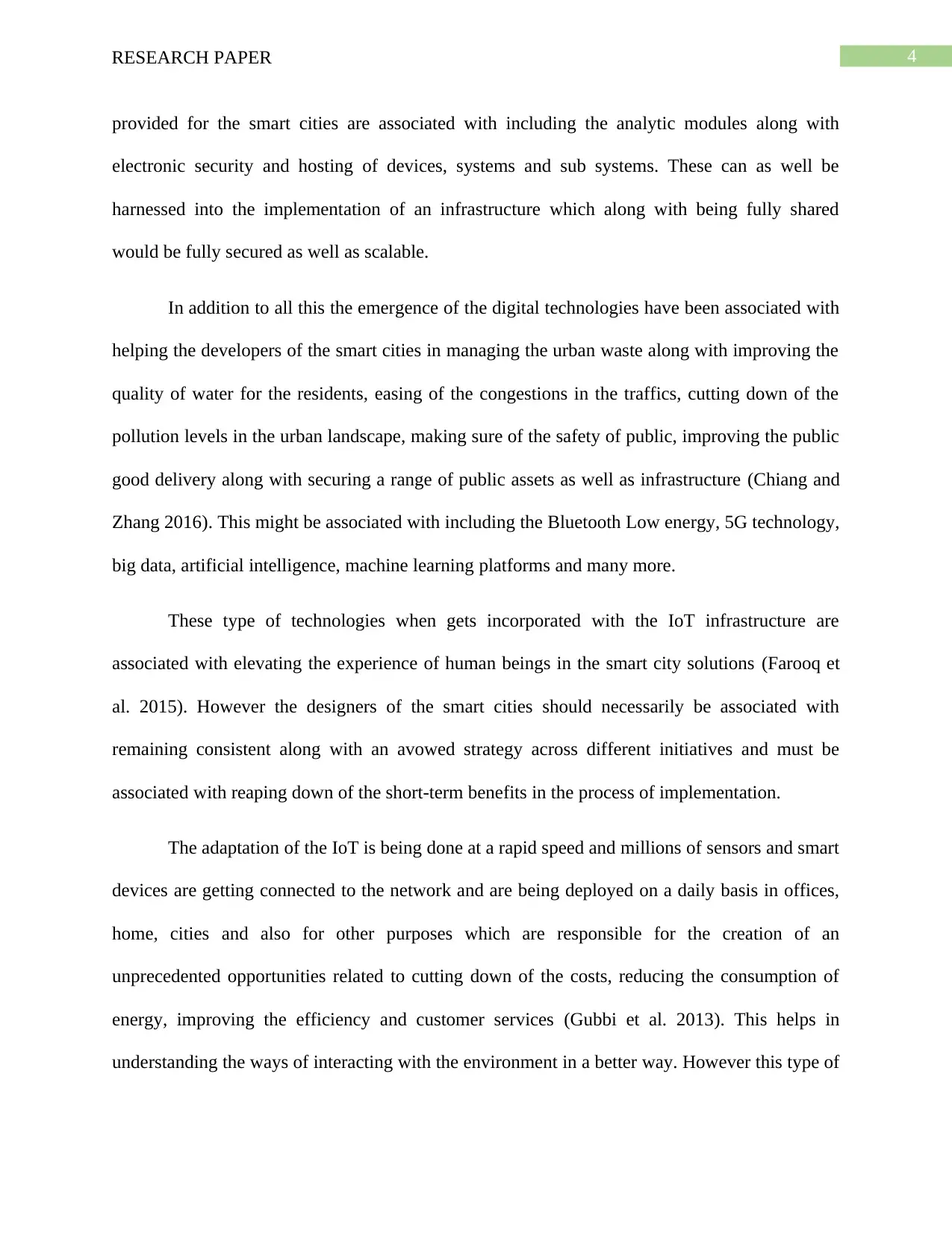
4RESEARCH PAPER
provided for the smart cities are associated with including the analytic modules along with
electronic security and hosting of devices, systems and sub systems. These can as well be
harnessed into the implementation of an infrastructure which along with being fully shared
would be fully secured as well as scalable.
In addition to all this the emergence of the digital technologies have been associated with
helping the developers of the smart cities in managing the urban waste along with improving the
quality of water for the residents, easing of the congestions in the traffics, cutting down of the
pollution levels in the urban landscape, making sure of the safety of public, improving the public
good delivery along with securing a range of public assets as well as infrastructure (Chiang and
Zhang 2016). This might be associated with including the Bluetooth Low energy, 5G technology,
big data, artificial intelligence, machine learning platforms and many more.
These type of technologies when gets incorporated with the IoT infrastructure are
associated with elevating the experience of human beings in the smart city solutions (Farooq et
al. 2015). However the designers of the smart cities should necessarily be associated with
remaining consistent along with an avowed strategy across different initiatives and must be
associated with reaping down of the short-term benefits in the process of implementation.
The adaptation of the IoT is being done at a rapid speed and millions of sensors and smart
devices are getting connected to the network and are being deployed on a daily basis in offices,
home, cities and also for other purposes which are responsible for the creation of an
unprecedented opportunities related to cutting down of the costs, reducing the consumption of
energy, improving the efficiency and customer services (Gubbi et al. 2013). This helps in
understanding the ways of interacting with the environment in a better way. However this type of
provided for the smart cities are associated with including the analytic modules along with
electronic security and hosting of devices, systems and sub systems. These can as well be
harnessed into the implementation of an infrastructure which along with being fully shared
would be fully secured as well as scalable.
In addition to all this the emergence of the digital technologies have been associated with
helping the developers of the smart cities in managing the urban waste along with improving the
quality of water for the residents, easing of the congestions in the traffics, cutting down of the
pollution levels in the urban landscape, making sure of the safety of public, improving the public
good delivery along with securing a range of public assets as well as infrastructure (Chiang and
Zhang 2016). This might be associated with including the Bluetooth Low energy, 5G technology,
big data, artificial intelligence, machine learning platforms and many more.
These type of technologies when gets incorporated with the IoT infrastructure are
associated with elevating the experience of human beings in the smart city solutions (Farooq et
al. 2015). However the designers of the smart cities should necessarily be associated with
remaining consistent along with an avowed strategy across different initiatives and must be
associated with reaping down of the short-term benefits in the process of implementation.
The adaptation of the IoT is being done at a rapid speed and millions of sensors and smart
devices are getting connected to the network and are being deployed on a daily basis in offices,
home, cities and also for other purposes which are responsible for the creation of an
unprecedented opportunities related to cutting down of the costs, reducing the consumption of
energy, improving the efficiency and customer services (Gubbi et al. 2013). This helps in
understanding the ways of interacting with the environment in a better way. However this type of
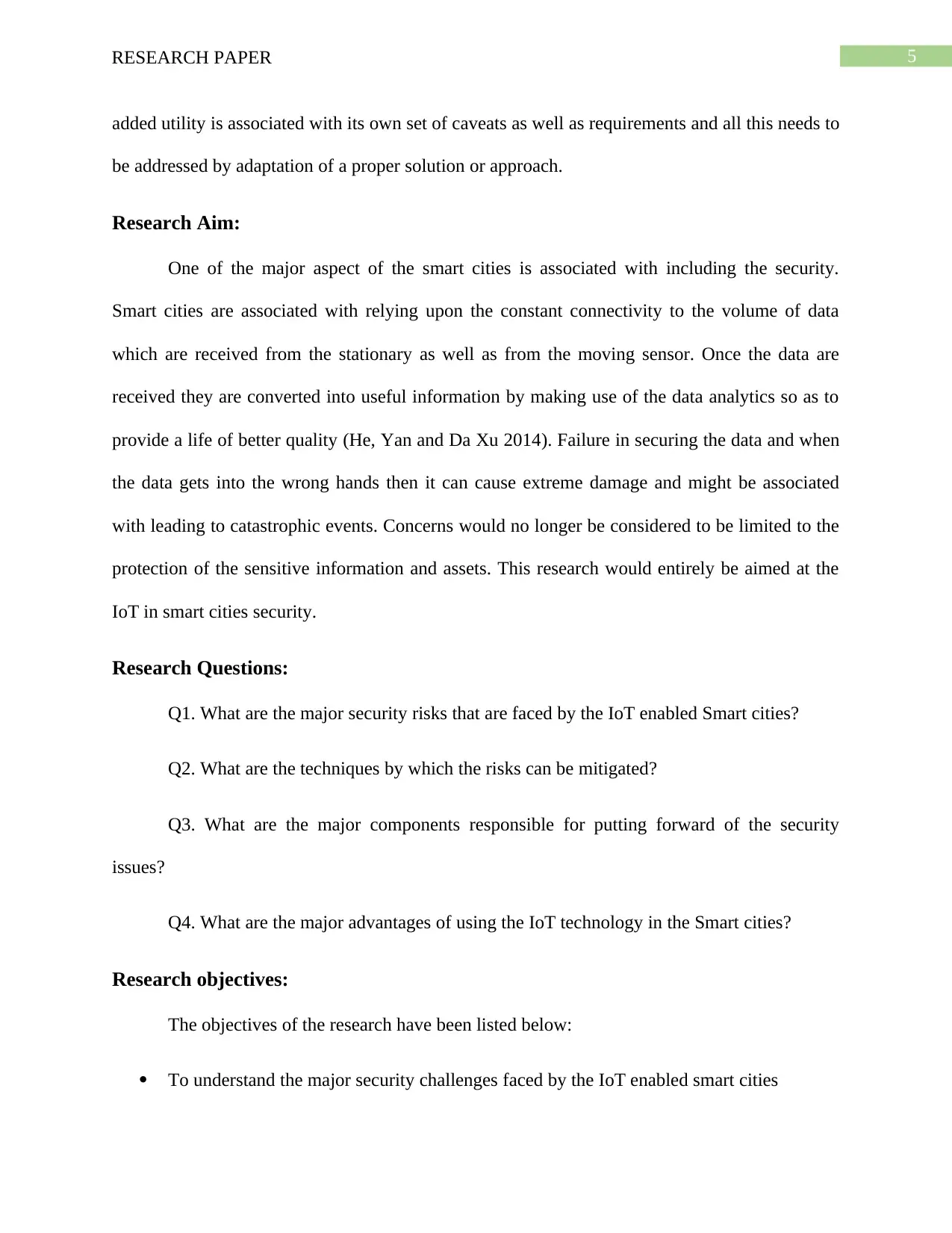
5RESEARCH PAPER
added utility is associated with its own set of caveats as well as requirements and all this needs to
be addressed by adaptation of a proper solution or approach.
Research Aim:
One of the major aspect of the smart cities is associated with including the security.
Smart cities are associated with relying upon the constant connectivity to the volume of data
which are received from the stationary as well as from the moving sensor. Once the data are
received they are converted into useful information by making use of the data analytics so as to
provide a life of better quality (He, Yan and Da Xu 2014). Failure in securing the data and when
the data gets into the wrong hands then it can cause extreme damage and might be associated
with leading to catastrophic events. Concerns would no longer be considered to be limited to the
protection of the sensitive information and assets. This research would entirely be aimed at the
IoT in smart cities security.
Research Questions:
Q1. What are the major security risks that are faced by the IoT enabled Smart cities?
Q2. What are the techniques by which the risks can be mitigated?
Q3. What are the major components responsible for putting forward of the security
issues?
Q4. What are the major advantages of using the IoT technology in the Smart cities?
Research objectives:
The objectives of the research have been listed below:
To understand the major security challenges faced by the IoT enabled smart cities
added utility is associated with its own set of caveats as well as requirements and all this needs to
be addressed by adaptation of a proper solution or approach.
Research Aim:
One of the major aspect of the smart cities is associated with including the security.
Smart cities are associated with relying upon the constant connectivity to the volume of data
which are received from the stationary as well as from the moving sensor. Once the data are
received they are converted into useful information by making use of the data analytics so as to
provide a life of better quality (He, Yan and Da Xu 2014). Failure in securing the data and when
the data gets into the wrong hands then it can cause extreme damage and might be associated
with leading to catastrophic events. Concerns would no longer be considered to be limited to the
protection of the sensitive information and assets. This research would entirely be aimed at the
IoT in smart cities security.
Research Questions:
Q1. What are the major security risks that are faced by the IoT enabled Smart cities?
Q2. What are the techniques by which the risks can be mitigated?
Q3. What are the major components responsible for putting forward of the security
issues?
Q4. What are the major advantages of using the IoT technology in the Smart cities?
Research objectives:
The objectives of the research have been listed below:
To understand the major security challenges faced by the IoT enabled smart cities
⊘ This is a preview!⊘
Do you want full access?
Subscribe today to unlock all pages.

Trusted by 1+ million students worldwide
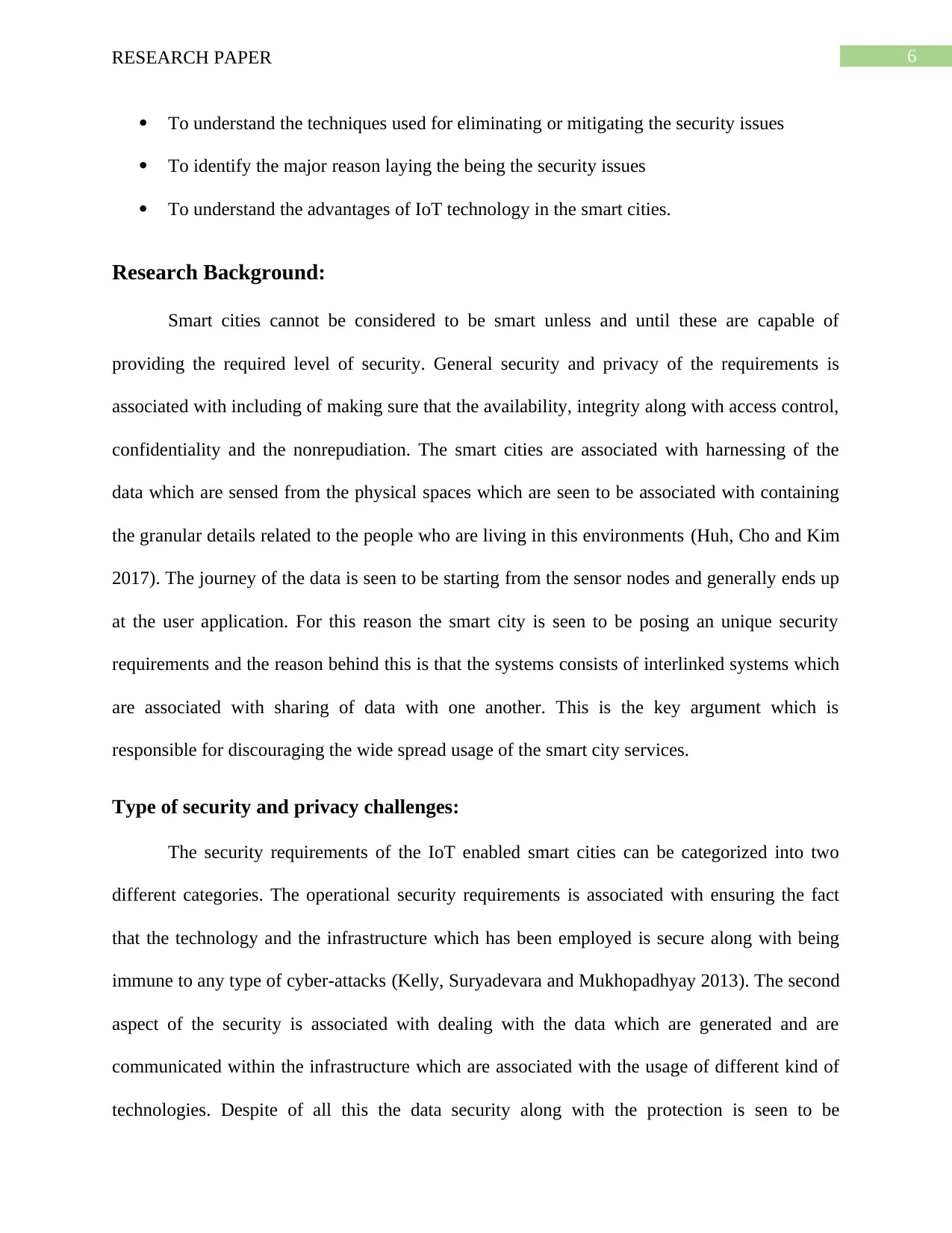
6RESEARCH PAPER
To understand the techniques used for eliminating or mitigating the security issues
To identify the major reason laying the being the security issues
To understand the advantages of IoT technology in the smart cities.
Research Background:
Smart cities cannot be considered to be smart unless and until these are capable of
providing the required level of security. General security and privacy of the requirements is
associated with including of making sure that the availability, integrity along with access control,
confidentiality and the nonrepudiation. The smart cities are associated with harnessing of the
data which are sensed from the physical spaces which are seen to be associated with containing
the granular details related to the people who are living in this environments (Huh, Cho and Kim
2017). The journey of the data is seen to be starting from the sensor nodes and generally ends up
at the user application. For this reason the smart city is seen to be posing an unique security
requirements and the reason behind this is that the systems consists of interlinked systems which
are associated with sharing of data with one another. This is the key argument which is
responsible for discouraging the wide spread usage of the smart city services.
Type of security and privacy challenges:
The security requirements of the IoT enabled smart cities can be categorized into two
different categories. The operational security requirements is associated with ensuring the fact
that the technology and the infrastructure which has been employed is secure along with being
immune to any type of cyber-attacks (Kelly, Suryadevara and Mukhopadhyay 2013). The second
aspect of the security is associated with dealing with the data which are generated and are
communicated within the infrastructure which are associated with the usage of different kind of
technologies. Despite of all this the data security along with the protection is seen to be
To understand the techniques used for eliminating or mitigating the security issues
To identify the major reason laying the being the security issues
To understand the advantages of IoT technology in the smart cities.
Research Background:
Smart cities cannot be considered to be smart unless and until these are capable of
providing the required level of security. General security and privacy of the requirements is
associated with including of making sure that the availability, integrity along with access control,
confidentiality and the nonrepudiation. The smart cities are associated with harnessing of the
data which are sensed from the physical spaces which are seen to be associated with containing
the granular details related to the people who are living in this environments (Huh, Cho and Kim
2017). The journey of the data is seen to be starting from the sensor nodes and generally ends up
at the user application. For this reason the smart city is seen to be posing an unique security
requirements and the reason behind this is that the systems consists of interlinked systems which
are associated with sharing of data with one another. This is the key argument which is
responsible for discouraging the wide spread usage of the smart city services.
Type of security and privacy challenges:
The security requirements of the IoT enabled smart cities can be categorized into two
different categories. The operational security requirements is associated with ensuring the fact
that the technology and the infrastructure which has been employed is secure along with being
immune to any type of cyber-attacks (Kelly, Suryadevara and Mukhopadhyay 2013). The second
aspect of the security is associated with dealing with the data which are generated and are
communicated within the infrastructure which are associated with the usage of different kind of
technologies. Despite of all this the data security along with the protection is seen to be
Paraphrase This Document
Need a fresh take? Get an instant paraphrase of this document with our AI Paraphraser
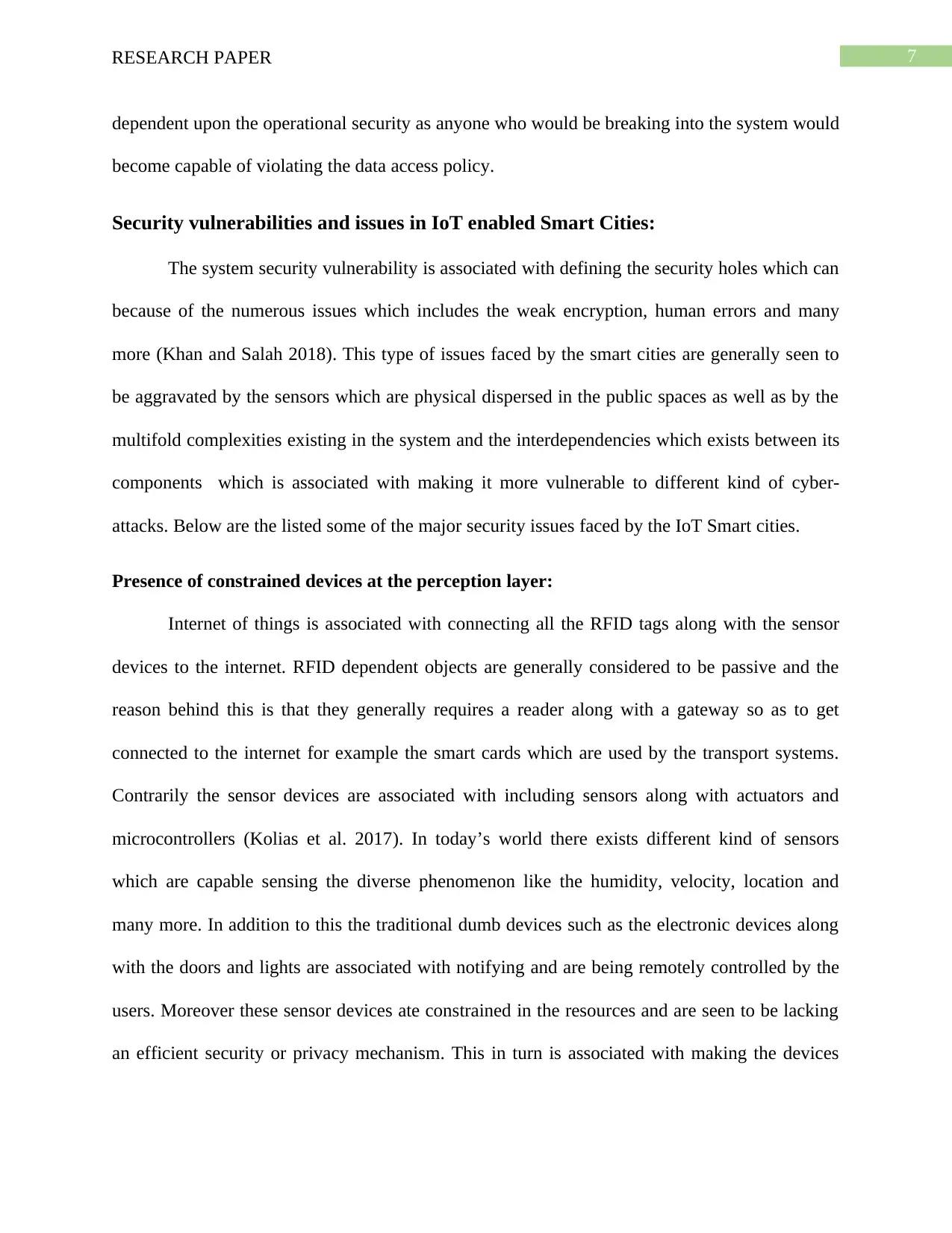
7RESEARCH PAPER
dependent upon the operational security as anyone who would be breaking into the system would
become capable of violating the data access policy.
Security vulnerabilities and issues in IoT enabled Smart Cities:
The system security vulnerability is associated with defining the security holes which can
because of the numerous issues which includes the weak encryption, human errors and many
more (Khan and Salah 2018). This type of issues faced by the smart cities are generally seen to
be aggravated by the sensors which are physical dispersed in the public spaces as well as by the
multifold complexities existing in the system and the interdependencies which exists between its
components which is associated with making it more vulnerable to different kind of cyber-
attacks. Below are the listed some of the major security issues faced by the IoT Smart cities.
Presence of constrained devices at the perception layer:
Internet of things is associated with connecting all the RFID tags along with the sensor
devices to the internet. RFID dependent objects are generally considered to be passive and the
reason behind this is that they generally requires a reader along with a gateway so as to get
connected to the internet for example the smart cards which are used by the transport systems.
Contrarily the sensor devices are associated with including sensors along with actuators and
microcontrollers (Kolias et al. 2017). In today’s world there exists different kind of sensors
which are capable sensing the diverse phenomenon like the humidity, velocity, location and
many more. In addition to this the traditional dumb devices such as the electronic devices along
with the doors and lights are associated with notifying and are being remotely controlled by the
users. Moreover these sensor devices ate constrained in the resources and are seen to be lacking
an efficient security or privacy mechanism. This in turn is associated with making the devices
dependent upon the operational security as anyone who would be breaking into the system would
become capable of violating the data access policy.
Security vulnerabilities and issues in IoT enabled Smart Cities:
The system security vulnerability is associated with defining the security holes which can
because of the numerous issues which includes the weak encryption, human errors and many
more (Khan and Salah 2018). This type of issues faced by the smart cities are generally seen to
be aggravated by the sensors which are physical dispersed in the public spaces as well as by the
multifold complexities existing in the system and the interdependencies which exists between its
components which is associated with making it more vulnerable to different kind of cyber-
attacks. Below are the listed some of the major security issues faced by the IoT Smart cities.
Presence of constrained devices at the perception layer:
Internet of things is associated with connecting all the RFID tags along with the sensor
devices to the internet. RFID dependent objects are generally considered to be passive and the
reason behind this is that they generally requires a reader along with a gateway so as to get
connected to the internet for example the smart cards which are used by the transport systems.
Contrarily the sensor devices are associated with including sensors along with actuators and
microcontrollers (Kolias et al. 2017). In today’s world there exists different kind of sensors
which are capable sensing the diverse phenomenon like the humidity, velocity, location and
many more. In addition to this the traditional dumb devices such as the electronic devices along
with the doors and lights are associated with notifying and are being remotely controlled by the
users. Moreover these sensor devices ate constrained in the resources and are seen to be lacking
an efficient security or privacy mechanism. This in turn is associated with making the devices
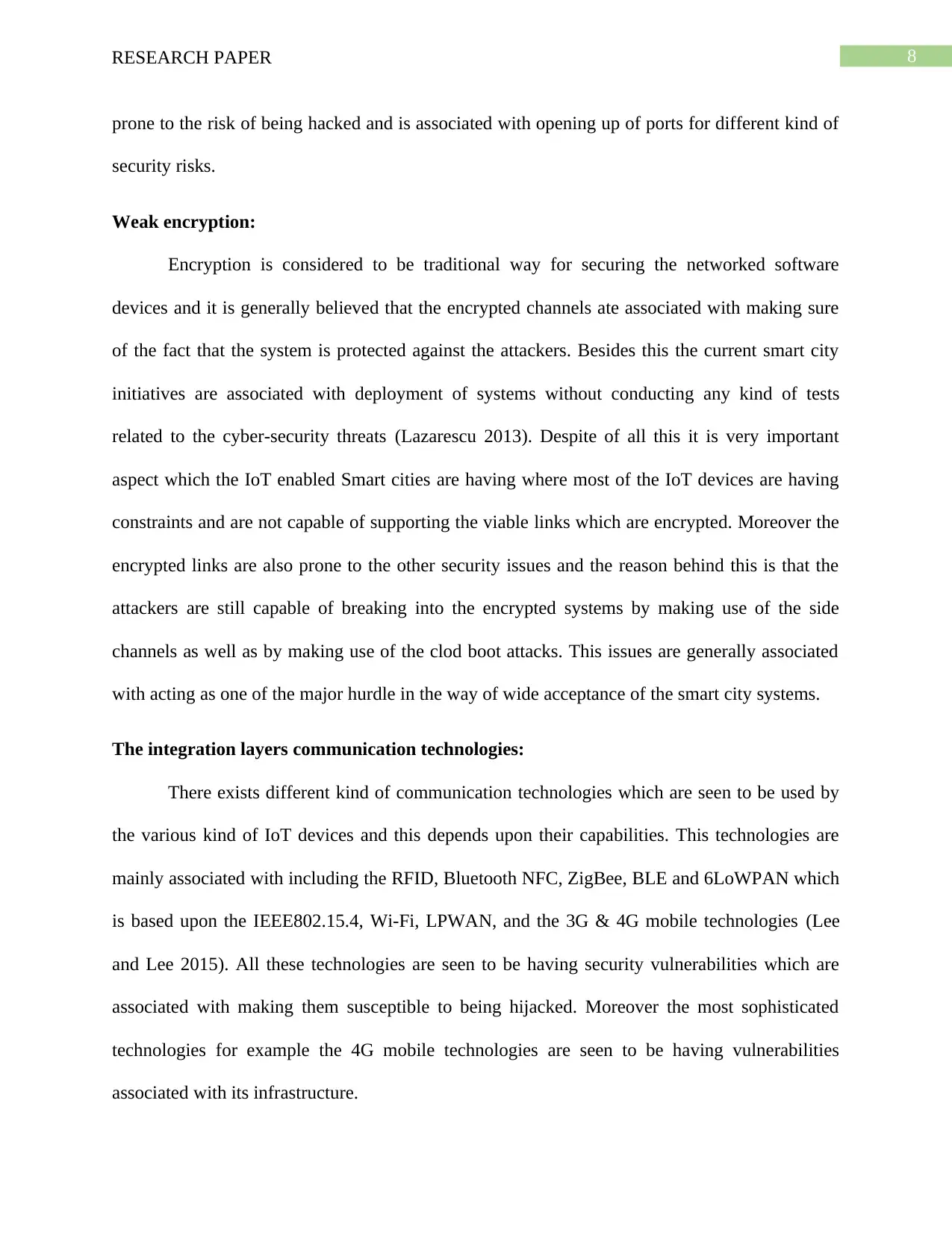
8RESEARCH PAPER
prone to the risk of being hacked and is associated with opening up of ports for different kind of
security risks.
Weak encryption:
Encryption is considered to be traditional way for securing the networked software
devices and it is generally believed that the encrypted channels ate associated with making sure
of the fact that the system is protected against the attackers. Besides this the current smart city
initiatives are associated with deployment of systems without conducting any kind of tests
related to the cyber-security threats (Lazarescu 2013). Despite of all this it is very important
aspect which the IoT enabled Smart cities are having where most of the IoT devices are having
constraints and are not capable of supporting the viable links which are encrypted. Moreover the
encrypted links are also prone to the other security issues and the reason behind this is that the
attackers are still capable of breaking into the encrypted systems by making use of the side
channels as well as by making use of the clod boot attacks. This issues are generally associated
with acting as one of the major hurdle in the way of wide acceptance of the smart city systems.
The integration layers communication technologies:
There exists different kind of communication technologies which are seen to be used by
the various kind of IoT devices and this depends upon their capabilities. This technologies are
mainly associated with including the RFID, Bluetooth NFC, ZigBee, BLE and 6LoWPAN which
is based upon the IEEE802.15.4, Wi-Fi, LPWAN, and the 3G & 4G mobile technologies (Lee
and Lee 2015). All these technologies are seen to be having security vulnerabilities which are
associated with making them susceptible to being hijacked. Moreover the most sophisticated
technologies for example the 4G mobile technologies are seen to be having vulnerabilities
associated with its infrastructure.
prone to the risk of being hacked and is associated with opening up of ports for different kind of
security risks.
Weak encryption:
Encryption is considered to be traditional way for securing the networked software
devices and it is generally believed that the encrypted channels ate associated with making sure
of the fact that the system is protected against the attackers. Besides this the current smart city
initiatives are associated with deployment of systems without conducting any kind of tests
related to the cyber-security threats (Lazarescu 2013). Despite of all this it is very important
aspect which the IoT enabled Smart cities are having where most of the IoT devices are having
constraints and are not capable of supporting the viable links which are encrypted. Moreover the
encrypted links are also prone to the other security issues and the reason behind this is that the
attackers are still capable of breaking into the encrypted systems by making use of the side
channels as well as by making use of the clod boot attacks. This issues are generally associated
with acting as one of the major hurdle in the way of wide acceptance of the smart city systems.
The integration layers communication technologies:
There exists different kind of communication technologies which are seen to be used by
the various kind of IoT devices and this depends upon their capabilities. This technologies are
mainly associated with including the RFID, Bluetooth NFC, ZigBee, BLE and 6LoWPAN which
is based upon the IEEE802.15.4, Wi-Fi, LPWAN, and the 3G & 4G mobile technologies (Lee
and Lee 2015). All these technologies are seen to be having security vulnerabilities which are
associated with making them susceptible to being hijacked. Moreover the most sophisticated
technologies for example the 4G mobile technologies are seen to be having vulnerabilities
associated with its infrastructure.
⊘ This is a preview!⊘
Do you want full access?
Subscribe today to unlock all pages.

Trusted by 1+ million students worldwide
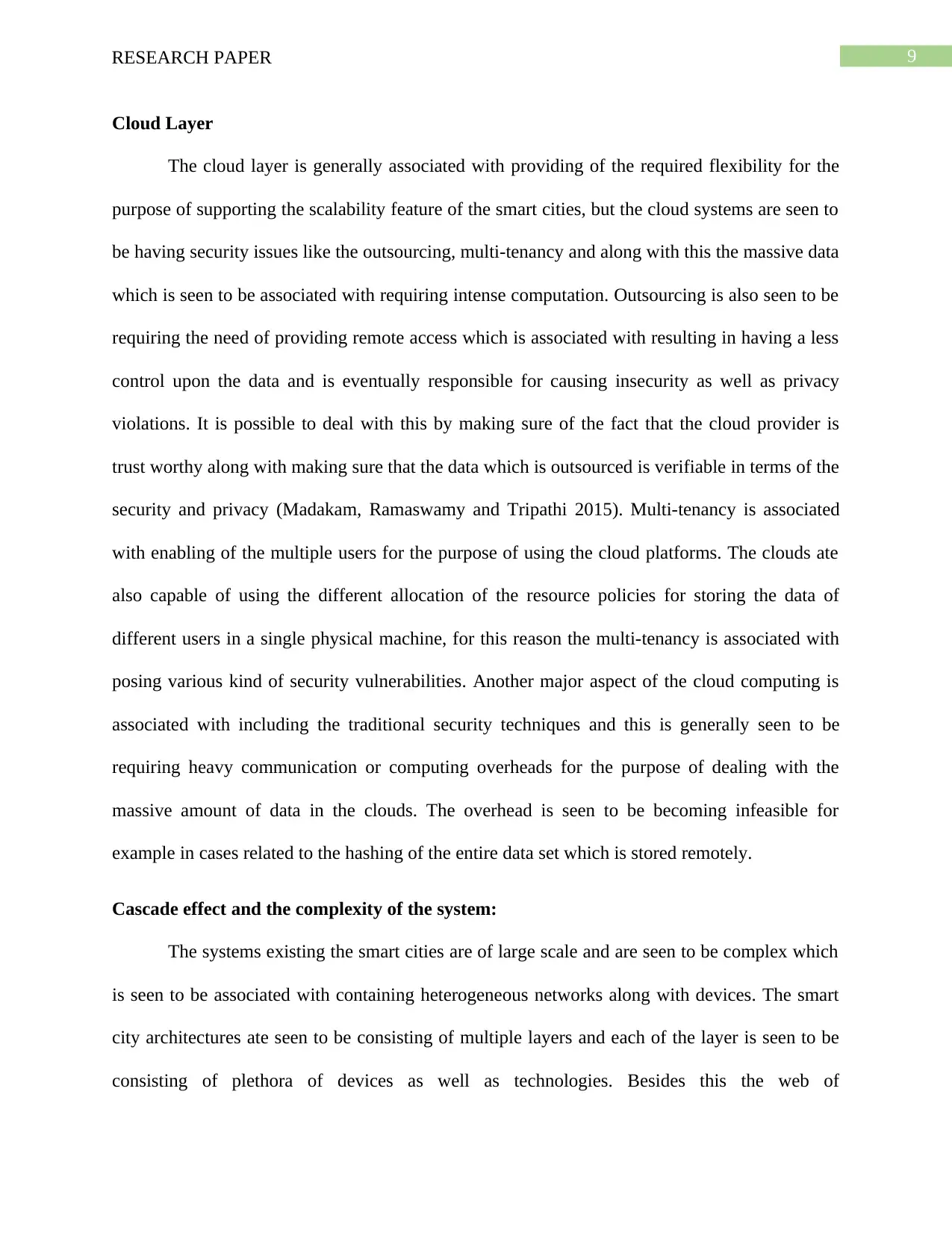
9RESEARCH PAPER
Cloud Layer
The cloud layer is generally associated with providing of the required flexibility for the
purpose of supporting the scalability feature of the smart cities, but the cloud systems are seen to
be having security issues like the outsourcing, multi-tenancy and along with this the massive data
which is seen to be associated with requiring intense computation. Outsourcing is also seen to be
requiring the need of providing remote access which is associated with resulting in having a less
control upon the data and is eventually responsible for causing insecurity as well as privacy
violations. It is possible to deal with this by making sure of the fact that the cloud provider is
trust worthy along with making sure that the data which is outsourced is verifiable in terms of the
security and privacy (Madakam, Ramaswamy and Tripathi 2015). Multi-tenancy is associated
with enabling of the multiple users for the purpose of using the cloud platforms. The clouds ate
also capable of using the different allocation of the resource policies for storing the data of
different users in a single physical machine, for this reason the multi-tenancy is associated with
posing various kind of security vulnerabilities. Another major aspect of the cloud computing is
associated with including the traditional security techniques and this is generally seen to be
requiring heavy communication or computing overheads for the purpose of dealing with the
massive amount of data in the clouds. The overhead is seen to be becoming infeasible for
example in cases related to the hashing of the entire data set which is stored remotely.
Cascade effect and the complexity of the system:
The systems existing the smart cities are of large scale and are seen to be complex which
is seen to be associated with containing heterogeneous networks along with devices. The smart
city architectures ate seen to be consisting of multiple layers and each of the layer is seen to be
consisting of plethora of devices as well as technologies. Besides this the web of
Cloud Layer
The cloud layer is generally associated with providing of the required flexibility for the
purpose of supporting the scalability feature of the smart cities, but the cloud systems are seen to
be having security issues like the outsourcing, multi-tenancy and along with this the massive data
which is seen to be associated with requiring intense computation. Outsourcing is also seen to be
requiring the need of providing remote access which is associated with resulting in having a less
control upon the data and is eventually responsible for causing insecurity as well as privacy
violations. It is possible to deal with this by making sure of the fact that the cloud provider is
trust worthy along with making sure that the data which is outsourced is verifiable in terms of the
security and privacy (Madakam, Ramaswamy and Tripathi 2015). Multi-tenancy is associated
with enabling of the multiple users for the purpose of using the cloud platforms. The clouds ate
also capable of using the different allocation of the resource policies for storing the data of
different users in a single physical machine, for this reason the multi-tenancy is associated with
posing various kind of security vulnerabilities. Another major aspect of the cloud computing is
associated with including the traditional security techniques and this is generally seen to be
requiring heavy communication or computing overheads for the purpose of dealing with the
massive amount of data in the clouds. The overhead is seen to be becoming infeasible for
example in cases related to the hashing of the entire data set which is stored remotely.
Cascade effect and the complexity of the system:
The systems existing the smart cities are of large scale and are seen to be complex which
is seen to be associated with containing heterogeneous networks along with devices. The smart
city architectures ate seen to be consisting of multiple layers and each of the layer is seen to be
consisting of plethora of devices as well as technologies. Besides this the web of
Paraphrase This Document
Need a fresh take? Get an instant paraphrase of this document with our AI Paraphraser
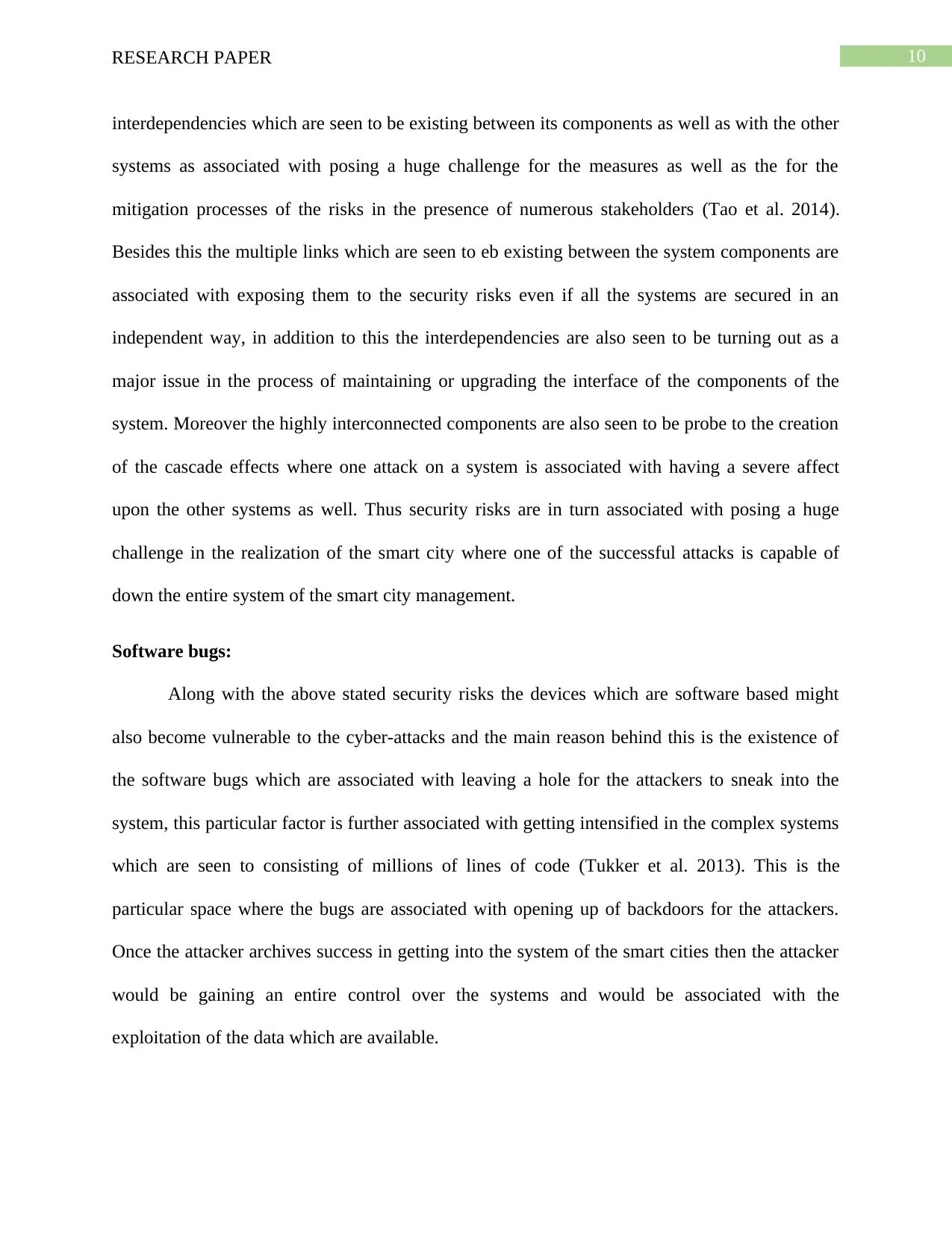
10RESEARCH PAPER
interdependencies which are seen to be existing between its components as well as with the other
systems as associated with posing a huge challenge for the measures as well as the for the
mitigation processes of the risks in the presence of numerous stakeholders (Tao et al. 2014).
Besides this the multiple links which are seen to eb existing between the system components are
associated with exposing them to the security risks even if all the systems are secured in an
independent way, in addition to this the interdependencies are also seen to be turning out as a
major issue in the process of maintaining or upgrading the interface of the components of the
system. Moreover the highly interconnected components are also seen to be probe to the creation
of the cascade effects where one attack on a system is associated with having a severe affect
upon the other systems as well. Thus security risks are in turn associated with posing a huge
challenge in the realization of the smart city where one of the successful attacks is capable of
down the entire system of the smart city management.
Software bugs:
Along with the above stated security risks the devices which are software based might
also become vulnerable to the cyber-attacks and the main reason behind this is the existence of
the software bugs which are associated with leaving a hole for the attackers to sneak into the
system, this particular factor is further associated with getting intensified in the complex systems
which are seen to consisting of millions of lines of code (Tukker et al. 2013). This is the
particular space where the bugs are associated with opening up of backdoors for the attackers.
Once the attacker archives success in getting into the system of the smart cities then the attacker
would be gaining an entire control over the systems and would be associated with the
exploitation of the data which are available.
interdependencies which are seen to be existing between its components as well as with the other
systems as associated with posing a huge challenge for the measures as well as the for the
mitigation processes of the risks in the presence of numerous stakeholders (Tao et al. 2014).
Besides this the multiple links which are seen to eb existing between the system components are
associated with exposing them to the security risks even if all the systems are secured in an
independent way, in addition to this the interdependencies are also seen to be turning out as a
major issue in the process of maintaining or upgrading the interface of the components of the
system. Moreover the highly interconnected components are also seen to be probe to the creation
of the cascade effects where one attack on a system is associated with having a severe affect
upon the other systems as well. Thus security risks are in turn associated with posing a huge
challenge in the realization of the smart city where one of the successful attacks is capable of
down the entire system of the smart city management.
Software bugs:
Along with the above stated security risks the devices which are software based might
also become vulnerable to the cyber-attacks and the main reason behind this is the existence of
the software bugs which are associated with leaving a hole for the attackers to sneak into the
system, this particular factor is further associated with getting intensified in the complex systems
which are seen to consisting of millions of lines of code (Tukker et al. 2013). This is the
particular space where the bugs are associated with opening up of backdoors for the attackers.
Once the attacker archives success in getting into the system of the smart cities then the attacker
would be gaining an entire control over the systems and would be associated with the
exploitation of the data which are available.
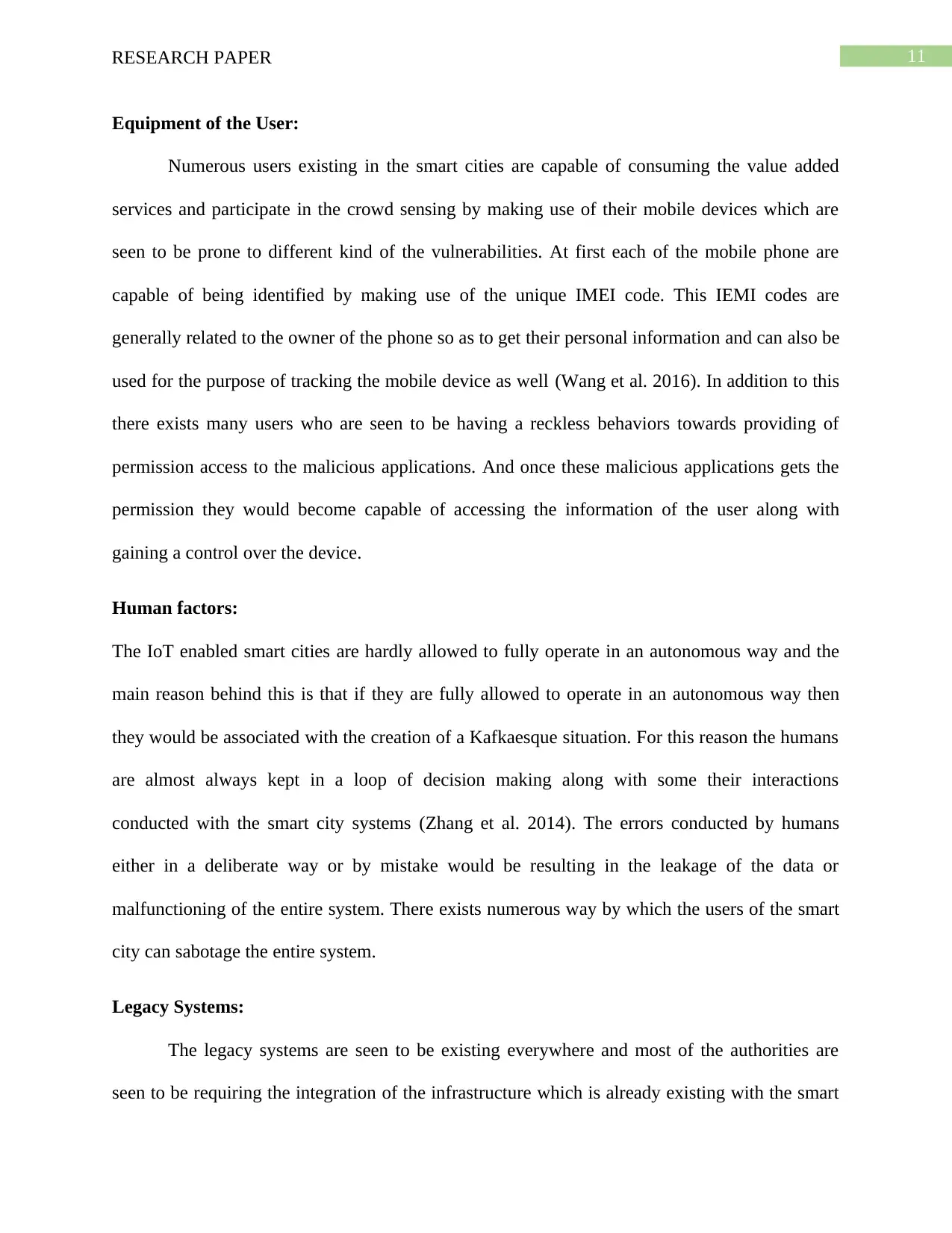
11RESEARCH PAPER
Equipment of the User:
Numerous users existing in the smart cities are capable of consuming the value added
services and participate in the crowd sensing by making use of their mobile devices which are
seen to be prone to different kind of the vulnerabilities. At first each of the mobile phone are
capable of being identified by making use of the unique IMEI code. This IEMI codes are
generally related to the owner of the phone so as to get their personal information and can also be
used for the purpose of tracking the mobile device as well (Wang et al. 2016). In addition to this
there exists many users who are seen to be having a reckless behaviors towards providing of
permission access to the malicious applications. And once these malicious applications gets the
permission they would become capable of accessing the information of the user along with
gaining a control over the device.
Human factors:
The IoT enabled smart cities are hardly allowed to fully operate in an autonomous way and the
main reason behind this is that if they are fully allowed to operate in an autonomous way then
they would be associated with the creation of a Kafkaesque situation. For this reason the humans
are almost always kept in a loop of decision making along with some their interactions
conducted with the smart city systems (Zhang et al. 2014). The errors conducted by humans
either in a deliberate way or by mistake would be resulting in the leakage of the data or
malfunctioning of the entire system. There exists numerous way by which the users of the smart
city can sabotage the entire system.
Legacy Systems:
The legacy systems are seen to be existing everywhere and most of the authorities are
seen to be requiring the integration of the infrastructure which is already existing with the smart
Equipment of the User:
Numerous users existing in the smart cities are capable of consuming the value added
services and participate in the crowd sensing by making use of their mobile devices which are
seen to be prone to different kind of the vulnerabilities. At first each of the mobile phone are
capable of being identified by making use of the unique IMEI code. This IEMI codes are
generally related to the owner of the phone so as to get their personal information and can also be
used for the purpose of tracking the mobile device as well (Wang et al. 2016). In addition to this
there exists many users who are seen to be having a reckless behaviors towards providing of
permission access to the malicious applications. And once these malicious applications gets the
permission they would become capable of accessing the information of the user along with
gaining a control over the device.
Human factors:
The IoT enabled smart cities are hardly allowed to fully operate in an autonomous way and the
main reason behind this is that if they are fully allowed to operate in an autonomous way then
they would be associated with the creation of a Kafkaesque situation. For this reason the humans
are almost always kept in a loop of decision making along with some their interactions
conducted with the smart city systems (Zhang et al. 2014). The errors conducted by humans
either in a deliberate way or by mistake would be resulting in the leakage of the data or
malfunctioning of the entire system. There exists numerous way by which the users of the smart
city can sabotage the entire system.
Legacy Systems:
The legacy systems are seen to be existing everywhere and most of the authorities are
seen to be requiring the integration of the infrastructure which is already existing with the smart
⊘ This is a preview!⊘
Do you want full access?
Subscribe today to unlock all pages.

Trusted by 1+ million students worldwide
1 out of 23
Related Documents
Your All-in-One AI-Powered Toolkit for Academic Success.
+13062052269
info@desklib.com
Available 24*7 on WhatsApp / Email
![[object Object]](/_next/static/media/star-bottom.7253800d.svg)
Unlock your academic potential
Copyright © 2020–2025 A2Z Services. All Rights Reserved. Developed and managed by ZUCOL.





